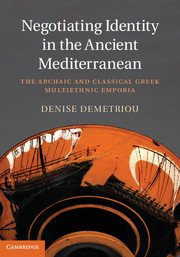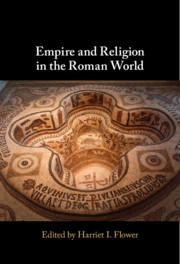Refine search
Actions for selected content:
23990 results in Ancient history
Chapter 10 - The Islamic East
- from B. - Regional Surveys
-
-
- Book:
- The Cambridge History of Judaism
- Published online:
- 21 August 2021
- Print publication:
- 02 September 2021, pp 332-368
-
- Chapter
- Export citation
Chapter 17 - Karaism
- from Part III - Spiritual and Intellectual History
-
-
- Book:
- The Cambridge History of Judaism
- Published online:
- 21 August 2021
- Print publication:
- 02 September 2021, pp 571-605
-
- Chapter
- Export citation

Negotiating Identity in the Ancient Mediterranean
- The Archaic and Classical Greek Multiethnic Emporia
-
- Published online:
- 30 August 2021
- Print publication:
- 22 November 2012

Empire and Religion in the Roman World
-
- Published online:
- 26 August 2021
- Print publication:
- 19 August 2021
Chapter 10 - Conclusion
-
- Book:
- Julius Caesar and the Roman People
- Published online:
- 05 August 2021
- Print publication:
- 26 August 2021, pp 580-615
-
- Chapter
- Export citation
One - Rethinking the Origins of Money
-
- Book:
- The Origins of Money in the Iron Age Mediterranean World
- Published online:
- 17 September 2021
- Print publication:
- 26 August 2021, pp 1-16
-
- Chapter
- Export citation
General Index
-
- Book:
- The Origins of Money in the Iron Age Mediterranean World
- Published online:
- 17 September 2021
- Print publication:
- 26 August 2021, pp 327-334
-
- Chapter
- Export citation
Chapter 8 - Caesar’s Leniency
-
- Book:
- Julius Caesar and the Roman People
- Published online:
- 05 August 2021
- Print publication:
- 26 August 2021, pp 413-487
-
- Chapter
- Export citation
Two - Outline of an Approach to Money
-
- Book:
- The Origins of Money in the Iron Age Mediterranean World
- Published online:
- 17 September 2021
- Print publication:
- 26 August 2021, pp 17-54
-
- Chapter
- Export citation
Appendix 5 - Where Were the 8th and 12th Legions When Caesar Marched into Italy?
- from Appendices
-
- Book:
- Julius Caesar and the Roman People
- Published online:
- 05 August 2021
- Print publication:
- 26 August 2021, pp 640-642
-
- Chapter
- Export citation
Contents
- from Two - Outline of an Approach to Money
-
- Book:
- The Origins of Money in the Iron Age Mediterranean World
- Published online:
- 17 September 2021
- Print publication:
- 26 August 2021, pp 17-17
-
- Chapter
- Export citation
Figures
-
- Book:
- Julius Caesar and the Roman People
- Published online:
- 05 August 2021
- Print publication:
- 26 August 2021, pp viii-viii
-
- Chapter
- Export citation
Preface
-
- Book:
- The Origins of Money in the Iron Age Mediterranean World
- Published online:
- 17 September 2021
- Print publication:
- 26 August 2021, pp xv-xvi
-
- Chapter
- Export citation
Contents
- from Six - Conclusion
-
- Book:
- The Origins of Money in the Iron Age Mediterranean World
- Published online:
- 17 September 2021
- Print publication:
- 26 August 2021, pp 228-228
-
- Chapter
- Export citation
Appendix 6 - “Caesar’s Passion to Be King’: Relative and Absolute Chronology
- from Appendices
-
- Book:
- Julius Caesar and the Roman People
- Published online:
- 05 August 2021
- Print publication:
- 26 August 2021, pp 643-646
-
- Chapter
- Export citation
Figures
-
- Book:
- The Origins of Money in the Iron Age Mediterranean World
- Published online:
- 17 September 2021
- Print publication:
- 26 August 2021, pp ix-x
-
- Chapter
- Export citation
Appendix 4 - The Civil War Crisis as a Prisoner’s Dilemma
- from Appendices
-
- Book:
- Julius Caesar and the Roman People
- Published online:
- 05 August 2021
- Print publication:
- 26 August 2021, pp 633-639
-
- Chapter
- Export citation
Maps
-
- Book:
- The Origins of Money in the Iron Age Mediterranean World
- Published online:
- 17 September 2021
- Print publication:
- 26 August 2021, pp xi-xii
-
- Chapter
- Export citation
Works Cited
-
- Book:
- Julius Caesar and the Roman People
- Published online:
- 05 August 2021
- Print publication:
- 26 August 2021, pp 647-674
-
- Chapter
- Export citation
Four - Money in the Iron Age Southern Levant
-
- Book:
- The Origins of Money in the Iron Age Mediterranean World
- Published online:
- 17 September 2021
- Print publication:
- 26 August 2021, pp 116-167
-
- Chapter
- Export citation
